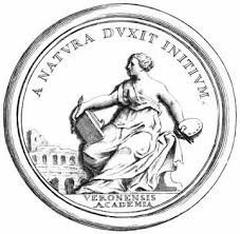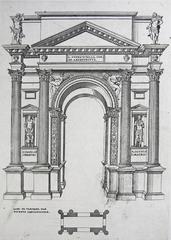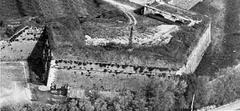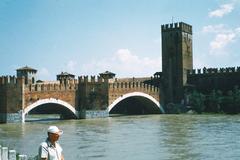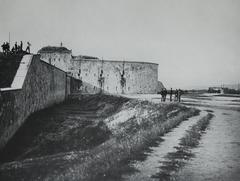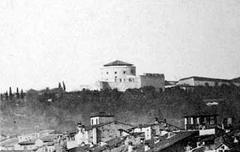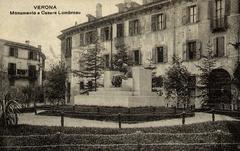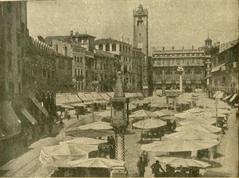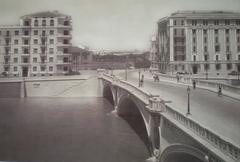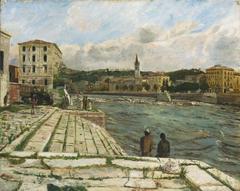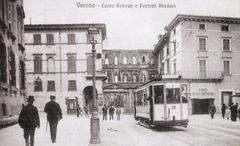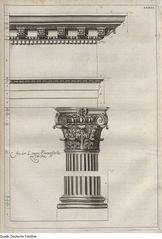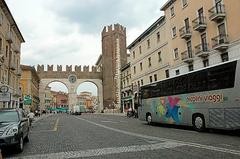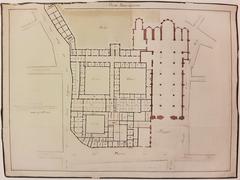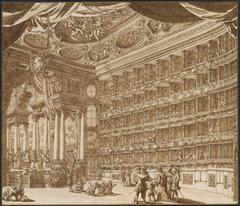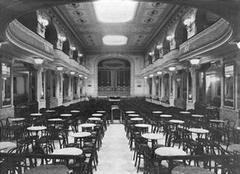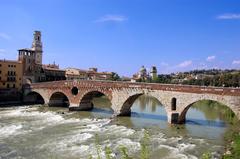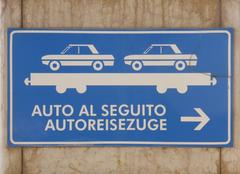
Santa Maria in Organo Verona: Visiting Hours, Tickets, and Historical Sites Guide
Date: 04/07/2025
Introduction
Nestled in the heart of Verona, Santa Maria in Organo is a living testament to centuries of faith, artistic mastery, and community life. With origins tracing back to the Lombard era, this Benedictine abbey-turned-parish is celebrated for its Renaissance architecture, intricate woodwork by Fra Giovanni da Verona, evocative frescoes, and unique artifacts like the “La Muletta” statue. Today, Santa Maria in Organo remains a vibrant spiritual and cultural hub, drawing visitors with its blend of art, history, and devotion.
This comprehensive guide offers everything you need to plan your visit: up-to-date visiting hours, ticket and accessibility details, guided tour options, nearby attractions, practical tips, and cultural context. Whether you’re an art lover, history buff, or casual traveler, discover why Santa Maria in Organo is a must-see among Verona’s historical sites.
1. Historical Overview
Early Origins and Lombard Foundations
Santa Maria in Organo stands as Verona’s oldest monastic institution, with origins in the 7th–8th centuries during the Lombard period. Established as a Benedictine abbey, the site played a pivotal role in the Christianization of northern Italy (Visit Verona). The church’s name may reference an ancient water organ or hydraulic structure, reflecting both its spiritual and practical significance in monastic life.
Medieval Development
Throughout the Middle Ages, the abbey flourished as a center of devotion and learning. Its strategic location near the Adige River fostered trade and communication, while successive expansions cemented its importance in Verona’s religious and civic identity.
Renaissance Transformation
A major Renaissance rebuilding occurred in the 15th century under the Olivetan Benedictines. The church was redesigned with elegant proportions and filled with natural light—hallmarks of Renaissance architecture. The most notable artistic additions were the exquisite woodwork and inlaid marquetry by Fra Giovanni da Verona (Visit Verona).
2. Architectural and Artistic Highlights
Exterior and Façade
The façade is a blend of unfinished Renaissance marble cladding and original Romanesque brickwork, resulting from 16th-century designs by Michele Sanmicheli (Corvinus). The portal, dating to 1592, marks the Renaissance influence, while the church’s Latin cross plan and bell tower reveal its architectural evolution.
Bell Tower
Completed in 1533 by Fra Giovanni da Verona, the Renaissance bell tower is slightly offset from the main axis, adding unique character. It houses five historic bells, noted as the first peal in Italy to use the Veronese bellringing technique (Wikipedia).
Crypt and “La Muletta”
Beneath the sanctuary lies the medieval crypt, one of the church’s oldest spaces. It houses “La Muletta,” a 13th-century polychrome wooden statue depicting Christ riding a donkey—a cherished symbol in local Palm Sunday processions (Verona Minor Hierusalem).
Fra Giovanni da Verona’s Woodwork
The sacristy wardrobes and choir stalls, crafted by Fra Giovanni, are masterpieces of Renaissance intarsia. The wardrobes display trompe-l’œil effects, architectural illusions, and narrative scenes, praised by Giorgio Vasari as the finest of their kind in Italy (Renato Prosciutto). The choir stalls feature inlays of biblical stories and geometric patterns, showcasing advanced perspective techniques.
Frescoes and Paintings
The church’s interior is adorned with works by major Veronese artists:
- Domenico and Francesco Morone: Narrative frescoes throughout the nave
- Niccolò Giolfino, Paolo Farinati, Domenico and Felice Brusasorzi: Contributed to the overall Renaissance decorative scheme (Corvinus)
- Andrea Mantegna’s “Pala Trivulzio”: Originally commissioned for the church, now housed in Milan’s Castello Sforzesco
3. Visiting Information
Visiting Hours (as of July 2025)
- Monday to Saturday: 9:00 AM – 12:00 PM and 3:00 PM – 6:00 PM
- Sunday and Religious Holidays: 3:00 PM – 6:00 PM (morning reserved for Mass) Hours may vary during special events or religious services; check the official parish website for updates.
Tickets and Entry
- Admission: Free for individual visitors; donations encouraged for preservation (Safarway).
- Guided Tours: Available through local guides or the parish office; group tours may require a small fee.
Accessibility
- Wheelchair Access: The main entrance has steps, but staff can assist visitors with mobility needs. The interior is mostly level, though some marble sections are uneven.
- Facilities: No public restrooms; nearby cafes and public facilities are available.
Location and Getting There
- Address: Piazzetta Santa Maria in Organo, 37129 Verona VR, Italy (Google Maps)
- Transport: City bus lines 70 and 73 stop at “Via Interrato dell’Acqua Morta” (ATV Verona). Walking from Piazza delle Erbe takes about 10 minutes.
4. Practical Tips and Visitor Guidelines
- Dress Code: Shoulders and knees covered; hats off inside.
- Silence: Maintain quiet, especially during religious services.
- Photography: Non-flash photography is generally allowed; check signage or confirm with staff during services.
- Food/Drink: Not permitted inside the church.
- Best Times to Visit: Weekdays and off-peak hours (early morning, late afternoon) for a quieter experience.
- Families: Children are welcome, but supervision is recommended due to delicate artworks and limited stroller space.
5. Nearby Attractions
Santa Maria in Organo’s central location allows you to combine your visit with:
- Verona Arena: Roman amphitheater
- Piazza delle Erbe: Historic city square
- Castelvecchio Museum: Medieval fortress and art museum
- Roman Theatre & Archaeological Museum: 300 meters away
- Giardino Giusti: Famous Renaissance gardens
- Ponte Pietra: Verona’s oldest bridge
Cafes, restaurants, and gelaterias are within easy walking distance.
6. Cultural Significance and Community Role
Santa Maria in Organo is more than a historic monument—it is an active center for worship, pilgrimage, and cultural engagement. Its legacy includes:
- Artistic Patronage: Hosting works by Veronese masters, including the Caroto brothers (churchesofvenice.com).
- Religious Life: Celebrations of Marian feasts and local processions.
- Community Involvement: Part of the “Verona Minor Hierusalem” initiative, promoting access to Verona’s lesser-known treasures (Verona Minor Hierusalem).
7. Frequently Asked Questions (FAQ)
Q: What are the current visiting hours?
A: Monday–Saturday: 9:00 AM–12:00 PM, 3:00 PM–6:00 PM; Sunday/holidays: 3:00 PM–6:00 PM.
Q: Is there an entrance fee?
A: Admission is free; donations are appreciated.
Q: Are guided tours available?
A: Yes, through local guides or the parish; booking ahead is recommended for groups.
Q: Is the church accessible for visitors with disabilities?
A: Staff can assist at the entrance; the interior is mostly level.
Q: Can I take photographs inside?
A: Non-flash photography is generally permitted; observe any posted restrictions.
Q: What are nearby attractions?
A: The Verona Arena, Piazza delle Erbe, Castelvecchio Museum, Roman Theatre, and Giardino Giusti are all within walking distance.
8. Contact Information
- Address: Piazzetta Santa Maria in Organo, 37129 Verona VR, Italy
- Phone: +39 045 800 2812 (parish office)
- Website: www.santamariainorgano.it
- Email: [email protected]
For updated information on hours, events, and group bookings, visit the official website.
9. Visuals and Media
Suggested images and alt tags:
- “Santa Maria in Organo Verona exterior”
- “Fra Giovanni da Verona wood inlays inside Santa Maria in Organo”
- “Gilded vaults and frescoes in Santa Maria in Organo”
- “View of Ponte Pietra near Santa Maria in Organo”
10. Summary and Call to Action
Santa Maria in Organo stands as a jewel in Verona’s crown—a place where centuries of history, faith, and artistry converge. From its Lombard foundations and Renaissance splendor to its ongoing role in community and worship, the church offers a profound cultural experience. Free entry, guided tour options, and a central location make it an ideal stop on your Verona itinerary.
Enhance your visit with digital resources like the Audiala app for audio guides and event updates. For further exploration, check out related articles on Verona’s historical sites and follow official channels for news and inspiration.
Plan your visit today to witness firsthand the enduring beauty, spiritual atmosphere, and Renaissance artistry that define Santa Maria in Organo. For details and the latest updates, consult the official Santa Maria in Organo page on Visit Verona and the Verona Minor Hierusalem website.
Sources
- Santa Maria In Organo Visiting Hours, Tickets & Verona Historical Sites Guide, 2025, Visit Verona
- Santa Maria in Organo Verona: Architectural Marvel & Artistic Treasure | Visiting Hours, Tickets & Guide, 2025, Wikipedia
- Cultural and Religious Significance, 2025, Churches of Venice
- Verona Minor Hierusalem
- Santa Maria in Organo Visiting Hours, Tickets, and Guide to Verona’s Historic Church, 2025, Safarway
- Parish Website

